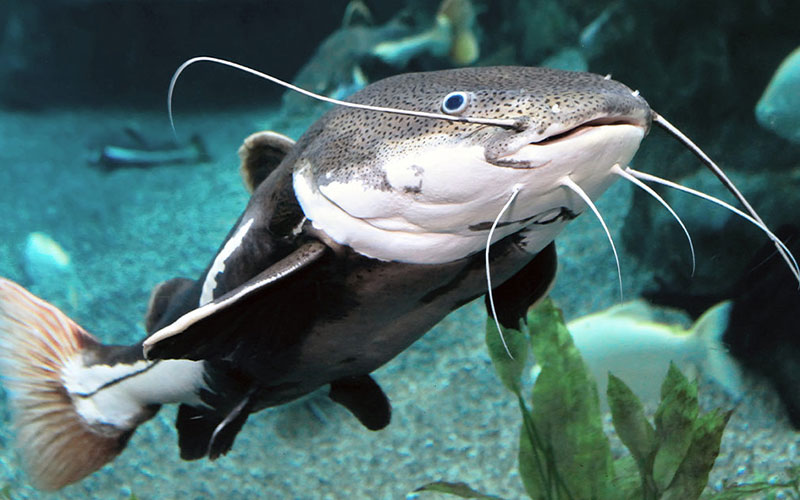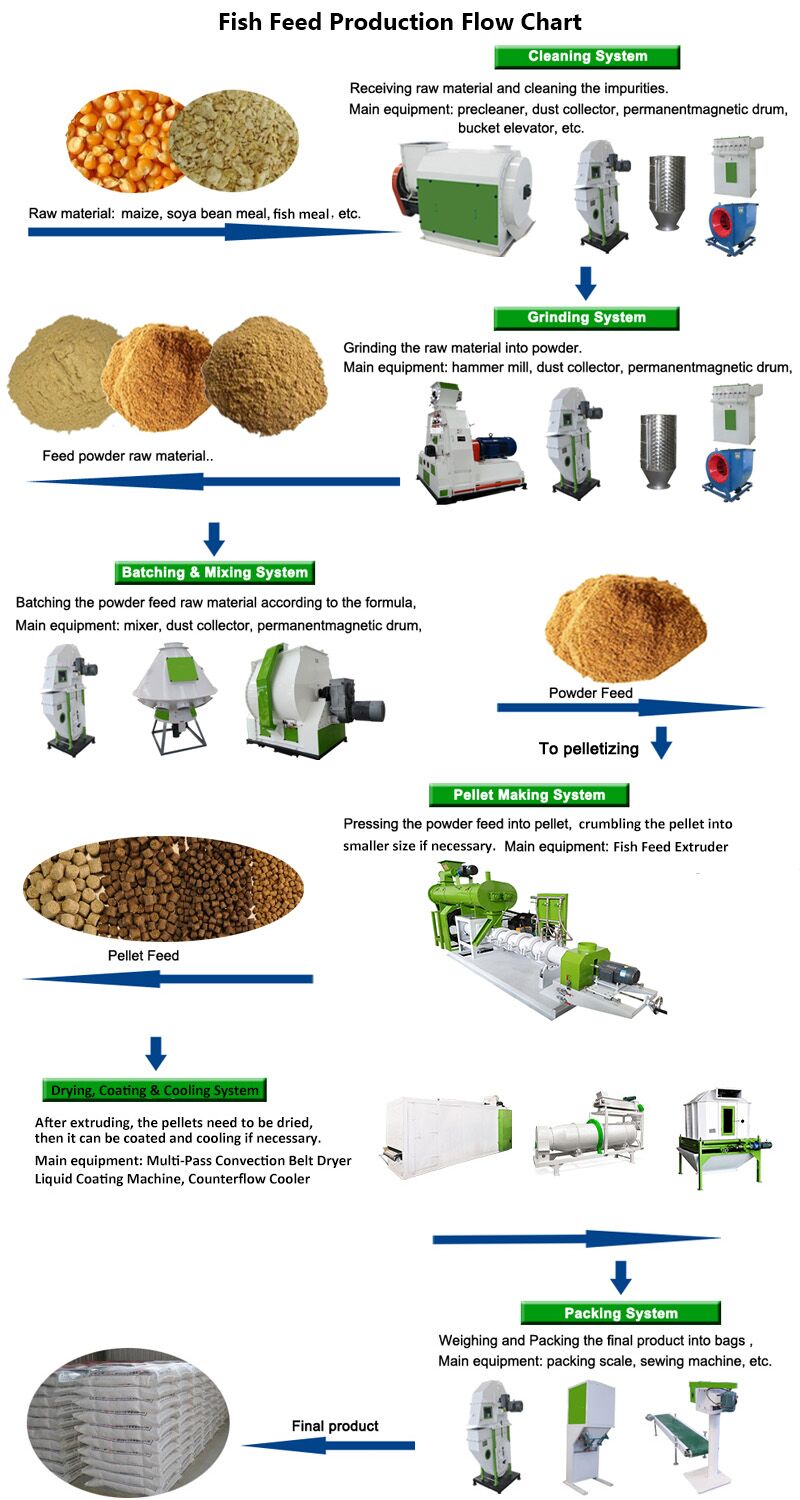
This is where you find all our press releases and news articles.
Catfish feeds are mainly plant-based, though feeds for fry and small fingerlings contain some fish meal and other animal proteins. Major ingredients used in catfish feeds generally include soybean meal, cottonseed meal, corn and by-products, and wheat by-products.Therefore, Cat Fish feed pellets must be produced with suitable equipment. Today I mainly introduce the equipment for the cat fish feed production line of 1-2t/h feed factory.
Yesterday, I received a Nigeria user’s inquiry on the production of fish feed pellets, the content is as follows:
"Good morning. My name is Kenneth, and i am new in cat fish rearing business. I intend doing small scale feed production for my farm. i came across, on the internet, the above mentioned machine models for fish food production. Therefore, i will like to know
1. the cost of the machines
2. mode and terms of delivering
3. if you have dealers in Nigeria and if yes, their contact..
Please give me some more information about your plant and quote me for a 1-2t/h Feed Making Plant Cat Fish Feed Production Line Equipment.
warmest regards"

Cat Fish
1. Raw material selection
Besides the nutritional value, the processing characteristics of aquatic feed raw materials should also be an important factor to be concerned about. The ideal processing characteristics of aquatic feed raw materials are not only manifested by larger output and less energy consumption in crushing, mixing or granulation, the more important point is that the final produced fish feed pellets must have good stability in water.
Starch is usually an important component in aquatic feeds, and the content of starch can be 5% to 60%. It is suggested that the starch content of sinking fish feed is 10% to 15%, and the starch content of floating fish feed is no less than 20%. In extruding fish feed pellets, carbohydrates act as adhesives, suspending agents, and emulsifiers. It is an important determinant of many structures and special sensory properties of extruded products.
2. Crushing
Crushing process can reduce raw material size to desired particle size. For producing 150-700kg/h fish feed pellets with regular requirements, the hammer mill is enough. For producing 1-10T/h fish feed pellets, the water-drop crusher is a must. For even larger aquatic feed manufacturing factory, the crushing process adopts secondary crushing technology, that is: first normal crushing, and then fine crushing.
3. Mixing
Mixing is one of the most important processes in aquatic feed production. If the physical properties of feed ingredients are the same, mixing is very simple. But as a matter of fact, the physical properties of feed ingredients are varied, and the problem of mixing and separation coexist. These physical properties include: particle size, particle shape, density or specific gravity, hygroscopicity, static charge and viscosity.
When adding material to the mixer, the smaller the ingredient is, the later it should be added., such as vitamins, minerals and drug premixture. Before adding oil or liquid, all dry ingredients must be mixed well (dry mixed). After dry mixing, spray oil or other liquids on the top, then mix again (wet mix). Horizontal twin screw mixer is the most commonly used mixer for aquatic feed. Usually there is a discharge port equal to the full length of the mixer at the bottom. Most fish feeds need to add some liquids. In some cases, they need to add some moist raw materials. In practice, it is generally allowed to add 10% of the liquid.
4. Conditioning (optional)
Conditioning is to add water and heat to the powdery material before making fish feed, it can: improve the digestibility and water resistance of feed, kill pathogenic bacteria. Usually this process is realized by wet type fish feed extruder, but its price is much higher. So, for ordinary fish feed production, this process is not necessary.
5. Fish feed pelletizing or extruding
For making fish feed pellets, there are mainly 2 types of machines: common feed pellet mill, fish feed extruder.
Common feed pellet mill can produce sinking fish feed and fish bait. Compare to making livestock or poultry feed pellets, the production of fish feed using feed pellet mill has the following features: 1. higher compression ratio.
Fish feed extruder:Nowadays, the most widely used fish feed extruder is single screw type. While the single screw fish feed extruder can also be divided into dry extruder and wet extruder. The fish feed extruder can produce all kinds of fish feed, like floating fish feed, sinking fish feed, slow sinking fish feed, and also semi-humid fish feed. However, as the feed extruding machine has complex operation, high price, and high production cost compared to common feed pellet mill, it is usually utilized in producing high grade aquatic feed.
6. Fish feed pellets drying
In order to prevent mildew of fish feed, aquatic feed must have good anticorrosive property. For fish feed factories, the most economical way is to reduce feed moisture, this is realized by dryer. The 3-layer drying machine can improve drying space and efficiency, at the same time screen fish feed pellets and seprate the powder. After heating and drying, the moisture content of the product is controlled below 11.5%, plus a well sealed outer package, generally, the feed can be stored safely for a long time. This physical anticorrosion method does not change the composition of feed, change the pH value of feed, nor affect the water quality of and feed quality. It is a safe and effective method.
7. Out-spraying
In fish or aquatic feed production, the edible oil and heat-sensitive components are usually sprayed by drum-type sprayer. When feed pellets fall, the vaporous liquid material is sprayed to them, so feed pellets can fully contact with droplets in the air. The main technical points of this external sparying technology are: (1) make the liquid atomized as much as possible. The smaller the droplets of atomization, the more uniform the distribution of liquid in the particles. To do this, the design of the spray nozzle is very important; (2) the weight of the particles and the liquid material match. The outside spraying process is a continuous operation process, so the water solubility of spraying liquid must be considered to avoid loss into the water.
8. Fish feed pellets cooling
The fish feed pellets, after spraying liquid, are conveyed to counter-flow cooler. The counter-flow cooler has many advantages in fish feed pellets processing, such as high automation, small air volume, low power consumption and small floor area.

In the short time that I’ve been in this business, I’ve realized that you’ll be more profitable if you make your own feed as opposed to buying feed from major producers.
Some farmers rely on floating feed from producers like Durante and Aqua Feed to grow their fishes, but due to the expensive nature of these fishes, it can be unprofitable on the long term.
If you learn how to make your own feed, though, you’ll save a lot more money and you can have more impact on your fishes since you can easily control what they are eating.
That said, here’s the formula I use for my fishes depending on the stage they are at; this formula uses the Hhanstholm 72% fish meal; I use local fish that can be gotten here in Nigeria depending on availability, but there is a lot of fluctuations in their availability, which became especially pronounced during the 2015 elections, ensuring there hasn’t been local fish that fish farmers can use for over 2 months now at the time of writing this, so I’m giving a formula based on the Hanstholm 72% fish meal, since this is always available:
Feed Formula for 200 – 600 Grams Catfish
Your catfishes are still very small and tender at this stage, so they need quality nutrient in their feed; this formula results in a feed rich in good protein but it is a bit expensive; it is not as expensive as using floating feed, though.
You should only have to use this feed formula for around 1 – 2 months.
(Based on this formula, 1 ton of fish feed will have: 250kg fish meal, 300kg soya meal, 200kg GNC, 200kg Dough, 50kg molasses)
The above are the main ingredients; you can then use other ingredients such as DCP (Dicalcium Phosphate), Methionine, Lysine, Salt, Vit. C, Fish Premixes, Antibiotics, etc. according to your preference.
Feed Formula for 600 Grams and Above
(Based on this formula, 1 ton of fish feed will have: 100kg fish meal, 400kg soya meal, 200kg GNC, 250kg Dough, 50kg molasses)
The above are the main ingredients; you can then use other ingredients such as DCP (Dicalcium Phosphate), Methionine, Lysine, Salt, Vit. C, Fish Premixes, Antibiotics, etc. according to your preference.
PS. In my own case, for 1 ton of feed I use the following: DCP (Dicalcium Phosphate): 10kg, Methionine: 1kg, Lysine: 1kg, Salt: 2 – 3kg, Vit. C: 1kg, Fish Premixes: 5kg, Antibiotics: Optional, unless my fishes are sick (in which case the quantity depends on the antibiotics used; it’s often around 500g to 2kg for 1 ton of feed, though)
Having the right mix of reliable, high-quality pellet machine and pelletizing systems and expert support is essential to your success. Watch how our end-to-end feed pellet plant solutions have helped our customers optimize their performance.
Our customized and future-proofed turnkey pellet plant solutions is designed with you at the core. From vision to reality and beyond, our team stays connected with yours. Giving you peace-of-mind with an expert at your side.

At RICHI, we go beyond project completion. With RICHI Servicee, we’re your dedicated partners in success. Count on us for expert guidance, minimal downtime, and optimized productivity. Choose RICHI for unmatched service and support.



Meet global product demands and quality standards with industry-leading pellet plant design, engineering, equipment, and construction services for pellet processors.


Your Partner Beyond Project Completion
2000+ cases
RICHI is the leading designer, manufacturer and builder of pellet plants in the world, completing over 2000 projects in 140 countries across 6 continents.
Read More
Increase plant productivity, profitability, and safety by integrating high quality equipment into your pellet production line. Over the years, RICHI has become China's top pellet equipment manufacturer. At the same time, RICHI has established valuable partnerships with the world's leading component and raw material manufacturers to bring you the best there is in technology, automation, and efficiency in pelleting plant machinery.

For nearly 30 years, RICHI has been providing best-in-class pellet plant equipment and services to clients across a variety of industries, sizes, and needs. We pride ourselves on the knowledge and skill that each team member possesses – from our technical sales team to our process design engineers. You can count on RICHI Machinery to take your operation to the next level of innovation, quality, and success.
Need help with your pellet manufacturing plant project? Contact us today.
ANIMAL FEED
BIOMASS
WOOD
ORGANIC FERTILIZER
AQUA FEED
CAT LITTER
MUNICIPAL WASTE RECYCLING
SPECIAL PELLET PRODUCTION
RICHI Machinery continues to deliver world class pellet mill equipment, pellet plant engineering and project solutions that add value to our customers in the animal feed, wood waste, agriculture waste, organic fertilizer, cat litter and special pellet products industries. Throughout the years, we RICHI Machinery have built strong brand, becoming industry-leading pellet machine manufacturer. We value integrity, promise quality, and prioritize your success.
Learn MoreWith our expert team, we precisely implement your process engineering requirements in pellet mill and pelletizing plant systems. No matter which industry you’re in – we understand your needs and deliver solutions that meet the highest standards.
At RICHI, quality comes first. Our pellet making machine and related pellet line equipment undergo rigorous quality controls to ensure they meet the highest standards. Rely on products that are durable, safe, and efficient.
With decades of experience in pellet machine and pellet production line production, we have earned a reputation as a trusted partner in various industries. Our expertise allows us to cover a wide range of applications.
Not only do we offer premium pelleting equipment, but we are also experts at designing, building, installing, and maintaining facilities from the ground up. Our expertise is within pellt plant process design, discovering the most efficient, productive, and profitable way to handle your materials in an end-to-end cycle.

Keeping in touch with us is an effective way to solve all your problems. If you have any needs or questions, please leave your contact information, then RICHI technical consultants will send design, quotation, videos to your mailbox. You can also contact us directly via WhatsApp: +86 13838389622
Copyright©2015-2024 by HENAN RICHI MACHINERY CO., LTD. All rights reserved.